Advertisements
Advertisements
प्रश्न
A 1 kg block is executing simple harmonic motion of amplitude 0.1 m on a smooth horizontal surface under the restoring force of a spring of spring constant 100 N/m. A block of mass 3 kg is gently placed on it at the instant it passes through the mean position. Assuming that the two blocks move together, find the frequency and the amplitude of the motion.
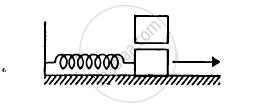
उत्तर
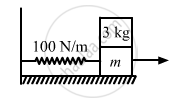
It is given that:
Amplitude of simple harmonic motion, x = 0.1 m
Total mass of the system, M = 3 + 1 = 4 kg (when both the blocks move together)
Spring constant, k = 100 N/m
Time period of SHM \[\left( T \right)\] is given by,
\[T = 2\pi\sqrt{\frac{M}{k}}\]
\[\text { On substituting the values of M and k in the bove equation, we have:
\[ T = 2\pi\sqrt{\frac{4}{100}} = \frac{2\pi}{5} s\]
\[\text { Frequency of the motion is given by, }\] \[ \frac{1}{T} = \frac{5}{2\pi} Hz\]
Let v be the velocity of the 1 kg block, at mean position.
\[\text { As kinetic energy is equal to the potential energy, we can write: }\] \[\frac{1}{2}m v^2 = \frac{1}{2}k x^2\]
where x = amplitude = 0.1 m
\[\text { Substituting the value of x in above equation and solving for v, we get: }\]
\[\left( \frac{1}{2} \right) \times \left( 1 \times v^2 \right) = \left( \frac{1}{2} \right) \times 100 \left( 0 . 1 \right)^2 \]
\[ v = 1 {ms}^{- 1} . . . \left( 1 \right)\]
Let V be the velocity of 4 kg block.
Now,
Initial momentum = Final momentum
∴ 1 × v = 4 × V
\[\text { Mean value of kinetic energy is given as, }\]
\[KE \text { at mean position }= \frac{1}{2}M V^2 \]
\[ = \left( \frac{1}{2} \right) \times 4 \times \left( \frac{1}{4} \right)^2 = \frac{1}{2} \times \frac{1}{4} = \frac{1}{8}\]
At the extreme position, the spring-mass system has only potential energy.
\[\therefore \frac{1}{4} = 100 \delta^2 \]
\[ = \delta = \sqrt{\left( \frac{1}{400} \right)}\]
\[ = 0 . 05 \text{ m } = 5 \text{ cm }\]
APPEARS IN
संबंधित प्रश्न
A particle executes simple harmonic motion with an amplitude of 10 cm. At what distance from the mean position are the kinetic and potential energies equal?
A particle having mass 10 g oscillates according to the equation x = (2.0 cm) sin [(100 s−1)t + π/6]. Find (a) the amplitude, the time period and the spring constant. (c) the position, the velocity and the acceleration at t = 0.
A block suspended from a vertical spring is in equilibrium. Show that the extension of the spring equals the length of an equivalent simple pendulum, i.e., a pendulum having frequency same as that of the block.
A body of mass 2 kg suspended through a vertical spring executes simple harmonic motion of period 4 s. If the oscillations are stopped and the body hangs in equilibrium find the potential energy stored in the spring.
The block of mass m1 shown in figure is fastened to the spring and the block of mass m2 is placed against it. (a) Find the compression of the spring in the equilibrium position. (b) The blocks are pushed a further distance (2/k) (m1 + m2)g sin θ against the spring and released. Find the position where the two blocks separate. (c) What is the common speed of blocks at the time of separation?

The spring shown in figure is unstretched when a man starts pulling on the cord. The mass of the block is M. If the man exerts a constant force F, find (a) the amplitude and the time period of the motion of the block, (b) the energy stored in the spring when the block passes through the equilibrium position and (c) the kinetic energy of the block at this position.
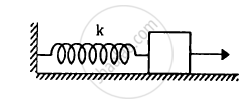
The springs shown in the figure are all unstretched in the beginning when a man starts pulling the block. The man exerts a constant force F on the block. Find the amplitude and the frequency of the motion of the block.
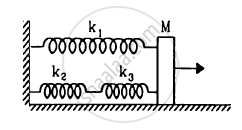
Find the elastic potential energy stored in each spring shown in figure, when the block is in equilibrium. Also find the time period of vertical oscillation of the block.
Solve the previous problem if the pulley has a moment of inertia I about its axis and the string does not slip over it.
Consider the situation shown in figure . Show that if the blocks are displaced slightly in opposite direction and released, they will execute simple harmonic motion. Calculate the time period.
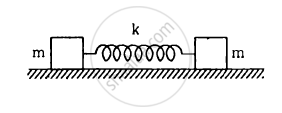
Find the elastic potential energy stored in each spring shown in figure when the block is in equilibrium. Also find the time period of vertical oscillation of the block.
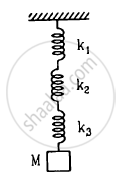
Discuss in detail the energy in simple harmonic motion.
If a body is executing simple harmonic motion and its current displacements is `sqrt3/2` times the amplitude from its mean position, then the ratio between potential energy and kinetic energy is:
Motion of an oscillating liquid column in a U-tube is ______.
A body is performing S.H.M. Then its ______.
- average total energy per cycle is equal to its maximum kinetic energy.
- average kinetic energy per cycle is equal to half of its maximum kinetic energy.
- mean velocity over a complete cycle is equal to `2/π` times of its π maximum velocity.
- root mean square velocity is times of its maximum velocity `1/sqrt(2)`.
Displacement versus time curve for a particle executing S.H.M. is shown in figure. Identify the points marked at which (i) velocity of the oscillator is zero, (ii) speed of the oscillator is maximum.

Find the displacement of a simple harmonic oscillator at which its P.E. is half of the maximum energy of the oscillator.
An object of mass 0.5 kg is executing a simple Harmonic motion. Its amplitude is 5 cm and the time period (T) is 0.2 s. What will be the potential energy of the object at an instant t = `T/4` s starting from the mean position? Assume that the initial phase of the oscillation is zero.
